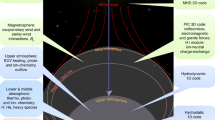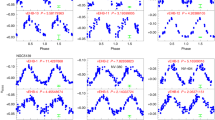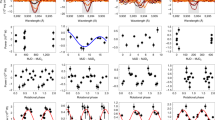Abstract
Observations of the infrared and optical light curves of hot giant exoplanets have demonstrated that the peak brightness is generally offset eastwards from the substellar point1,2. This observation is consistent with hydrodynamic numerical simulations producing fast, eastwards directed winds that advect the hottest point in the atmosphere eastwards of the substellar point3,4. However, recent continuous Kepler measurements of HAT-P-7 b show that its peak brightness offset varies considerably over time, with excursions such that the brightest point is sometimes westwards of the substellar point5. These variations in brightness offset require wind variability, with or without the presence of clouds. While such wind variability has not been seen in hydrodynamic simulations of hot giant exoplanet atmospheres, it has been seen in magnetohydrodynamic simulations6. Here I show that magnetohydrodynamic simulations of HAT-P-7 b indeed display variable winds and a corresponding variability in the position of the hottest point in the atmosphere. Assuming that the observed variability in HAT-P-7 b is due to magnetism, I constrain its minimum magnetic field strength to be 6 G. Similar observations of wind variability on hot giant exoplanets, or the lack thereof, could help constrain their magnetic field strengths. As dynamo simulations of these planets do not exist and theoretical scaling relations7 may not apply, such observational constraints could prove immensely useful.
This is a preview of subscription content, access via your institution
Access options
Access Nature and 54 other Nature Portfolio journals
Get Nature+, our best-value online-access subscription
$29.99 / 30 days
cancel any time
Subscribe to this journal
Receive 12 digital issues and online access to articles
$119.00 per year
only $9.92 per issue
Buy this article
- Purchase on Springer Link
- Instant access to full article PDF
Prices may be subject to local taxes which are calculated during checkout



Similar content being viewed by others
References
Knutson, H. A. et al. Multiwavelength constraints on the day–night circulation patterns of HD 189733b. Astrophys. J. 690, 822–836 (2009).
Wong, I. et al. 3.6 and 4.5 μm Spitzer phase curves of ten highly-irradiated hot Jupiters WASP-19b and HAT-P-7b. Astrophys. J. 680, 83–122 (2016).
Showman, A. P. & Guillot, T. Atmospheric circulation and tides of “51 Pegasus b-like” planets. Astron. Astrophys. 385, 166–180 (2002).
Dobbs-Dixon, I. & Lin, D. N. C. Atmospheric dynamics of short-period extrasolar gas giant planets. I. Dependence of nightside temperature on opacity. Astrophys. J. 673, 513–525 (2008).
Armstrong, D. J. et al. Variability in the atmosphere of the hot giant planet HAT-P-7b. Nat. Astron. 1, 0004 (2016).
Rogers, T. M. & Komacek, T. Magnetic effects in hot Jupiter atmospheres. Astrophys. J. 794, 132–144 (2014).
Christensen, U. Dynamo scaling laws and applications to the planets. Space Sci. Rev. 152, 565–590 (2010).
Rogers, T. M. On limiting the thickness of the solar tachocline. Astrophys. J. 733, 12–25 (2011).
Cooper, C. S. & Showman, A. P. Dynamic meteorology at the photosphere of HD 209458b. Astrophys. J. Lett. 629, L45–L48 (2005).
Rauscher, E. & Menou, K. Three-dimensional modeling of hot Jupiter atmospheric flows. Astrophys. J. 714, 1334–1342 (2010).
Perna, R., Menou, K. & Rauscher, E. Magnetic drag on hot Jupiter atmospheric winds. Astrophys. J. 719, 1421–1426 (2010).
Batygin, K. & Stevenson, D. J. Inflating hot Jupiters with ohmic dissipation. Astrophys. J. Lett. 714, L238–L243 (2010).
Menou, K. Magnetic scaling laws for the atmospheres of hot giant exoplanets. Astrophys. J. 745, 138–146 (2012).
Rogers, T. & McElwaine, J. The hottest hot-Jupiters may host atmospheric dynamos. Astrophys. J. Lett. Preprint at https://arxiv.org/abs/1704.04197 (2017).
Perez-Becker, D. & Showman, A. P. Atmospheric heat redistribution on hot Jupiters. Astrophys. J. 776, 134–150 (2013).
Stevenson, D. Turbulent thermal convection in the presence of rotation and a magnetic field — a heuristic theory. Geophys. Astrophys. Fluid Dynam. 12, 139–169 (1979).
Vidotto, A., Jardine, M. & Helling, C. Early UV ingress in WASP-12b: measuring planetary magnetic fields. Astrophys. J. Lett. 722, 168–172 (2010).
Barman, T. S., Hauschildt, P. H. & Allard, F. Phase-dependent properties of extrasolar planet atmospheres. Astrophys. J. 632, 1132–1139 (2005).
Agol, E. et al. The climate of HD 189733b from fourteen transits and eclipses measured by Spitzer. Astrophys. J. 721, 1861–1877 (2010).
Kislyakova, K. G., Holmstrom, M., Lammer, H., Odert, P. & Khodachenko, M. L. Magnetic moment and plasma environment of HD 209458b as determined from Lyα observations. Science 346, 981–983 (2014).
Gough, D. O. The anelastic approximation for thermal convection. J. Atmos. Sci. 26, 448–456 (1969).
Rogers, T. M. & Glatzmaier, G. A. Penetrative convection within the anelastic approximation. Astrophys. J. 620, 432–445 (2005).
Rauscher, E. & Menou, K. Three-dimensional atmospheric circulation models of HD 189733 b and HD209458 b with consistent magnetic drag and ohmic dissipation. Astrophys. J. 764, 103–121 (2013).
Lodders, K. in Principles and Perspectives in Cosmochemistry (eds Goswani, A. & Reddy, B. E. ) 379–417 (Springer, 2010).
Iro, N., Bézard, B. & Guillot, T. A time-dependent radiative model of HD 209458b. Astron. Astrophys. 436, 719–727 (2005).
Rogers, T. M. & Showman, A. P. Magnetohydrodynamic simulations of the atmosphere of HD 209458b. Astrophys. J. Lett. 782, L4–L10 (2014).
Acknowledgements
T.M.R. thanks J. McElwaine and G. Glatzmaier for helpful discussions leading to this paper and J. Vriesema for help with the graphics. Figure 1 was produced using VAPOR. Funding for this work was provided by NASA (National Aeronautics and Space Administration) grant NNX13AG80G and the computing was carried out on Pleiades at NASA Ames.
Author information
Authors and Affiliations
Corresponding author
Ethics declarations
Competing interests
The author declares no competing financial interests.
Supplementary information
Supplementary Information
Supplementary Video 1 caption, Supplementary Figures 1,2 (PDF 134 kb)
Supplementary Video
Supplementary Video 1 (MOV 126484 kb)
Rights and permissions
About this article
Cite this article
Rogers, T. Constraints on the magnetic field strength of HAT-P-7 b and other hot giant exoplanets. Nat Astron 1, 0131 (2017). https://doi.org/10.1038/s41550-017-0131
Received:
Accepted:
Published:
DOI: https://doi.org/10.1038/s41550-017-0131
This article is cited by
-
Revealing the atmospheres of highly irradiated exoplanets: from ultra-hot Jupiters to rocky worlds
Astrophysics and Space Science (2023)
-
A broadband thermal emission spectrum of the ultra-hot Jupiter WASP-18b
Nature (2023)
-
A survey of exoplanet phase curves with Ariel
Experimental Astronomy (2022)
-
Possible Atmospheric Diversity of Low Mass Exoplanets – Some Central Aspects
Space Science Reviews (2020)
-
Atmospheric Dynamics of Hot Giant Planets and Brown Dwarfs
Space Science Reviews (2020)



